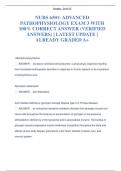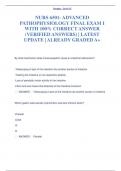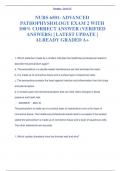Nurs 6501 advanced pathophysiology
Looking for study notes at Nurs 6501 advanced pathophysiology? On Stuvia you will find more than 360 summaries, study notes and other study resources for all courses at Nurs 6501 advanced pathophysiology.
Courses at Nurs 6501 advanced pathophysiology
Notes available for the following courses at Nurs 6501 advanced pathophysiology
Latest notes & summaries Nurs 6501 advanced pathophysiology

Absolute polycythemia ANSWER: excessive red blood cell production; a physiologic response resulting from increased erythropoietin secretion in response to chronic hypoxia or as a symptom of polycythemia vera. Absorption atelectasis ANSWER: see Atelectasis. Acid maltase deficiency (glycogen storage disease type II or Pompe disease) ANSWER: an autosomal recessive metabolic disorder that damages muscle and nerve cells throughout the body by an accumulation of glycogen in the lysosome ...
- Package deal
- Exam (elaborations)
- • 190 pages's •
-
NURS 6501 ADVANCED PATHOPHYSIOLOGY•NURS 6501 ADVANCED PATHOPHYSIOLOGY
-
Mastering Pathophysiology Excellence Package• ByScoreSmart
Preview 4 out of 190 pages
Absolute polycythemia ANSWER: excessive red blood cell production; a physiologic response resulting from increased erythropoietin secretion in response to chronic hypoxia or as a symptom of polycythemia vera. Absorption atelectasis ANSWER: see Atelectasis. Acid maltase deficiency (glycogen storage disease type II or Pompe disease) ANSWER: an autosomal recessive metabolic disorder that damages muscle and nerve cells throughout the body by an accumulation of glycogen in the lysosome ...

Vesicollobullous disorders is a type of mucocutaneous disease characterized by vesicles and bullae. What are some examples? ANSWER: Pemphigus, bulbous pemphigoid, erythema multiforme, SJS, TEN Types of Angina ANSWER: stable, unstable, variant/printzmetal, silent A 3-day old infant is noted to have a mildly elevated unconjugated bilirubin level and icterus. Your concern is that this child may have: a. physiologic jaundice b. kernicterus c. glucose-6-phosphate dehydrogenase deficiency...
- Package deal
- Exam (elaborations)
- • 47 pages's •
-
NURS 6501 ADVANCED PATHOPHYSIOLOGY•NURS 6501 ADVANCED PATHOPHYSIOLOGY
-
Mastering Pathophysiology Excellence Package• ByScoreSmart
Preview 4 out of 47 pages
Vesicollobullous disorders is a type of mucocutaneous disease characterized by vesicles and bullae. What are some examples? ANSWER: Pemphigus, bulbous pemphigoid, erythema multiforme, SJS, TEN Types of Angina ANSWER: stable, unstable, variant/printzmetal, silent A 3-day old infant is noted to have a mildly elevated unconjugated bilirubin level and icterus. Your concern is that this child may have: a. physiologic jaundice b. kernicterus c. glucose-6-phosphate dehydrogenase deficiency...

By what mechanism does intussusception cause an intestinal obstruction? -Telescoping of part of the intestine into another section of intestine -Twisting the intestine on its mesenteric pedicle -Loss of peristaltic motor activity in the intestine -Fibrin and scar tissue that attaches to the intestinal omentum ANSWER: -Telescoping of part of the intestine into another section of intestine Which gastric cells secrete hydrochloric acid and intrinsic factor? -Parietal -Chief -G -D ANSWE...
- Package deal
- Exam (elaborations)
- • 32 pages's •
-
NURS 6501 ADVANCED PATHOPHYSIOLOGY•NURS 6501 ADVANCED PATHOPHYSIOLOGY
-
Mastering Pathophysiology Excellence Package• ByScoreSmart
Preview 4 out of 32 pages
By what mechanism does intussusception cause an intestinal obstruction? -Telescoping of part of the intestine into another section of intestine -Twisting the intestine on its mesenteric pedicle -Loss of peristaltic motor activity in the intestine -Fibrin and scar tissue that attaches to the intestinal omentum ANSWER: -Telescoping of part of the intestine into another section of intestine Which gastric cells secrete hydrochloric acid and intrinsic factor? -Parietal -Chief -G -D ANSWE...

1. Which statement made by a student indicates the healthcare professional needs to describe the pericardium again? a. The pericardium is a double-walled membranous sac that encloses the heart. b. It is made up of connective tissue and a surface layer of squamous cells. c. The pericardium protects the heart against infection and inflammation from the lungs and pleural space. d. It contains pain and mechanoreceptors that can elicit reflex changes in blood pressure and heart rate. ANSW...
- Package deal
- Exam (elaborations)
- • 22 pages's •
-
NURS 6501 ADVANCED PATHOPHYSIOLOGY•NURS 6501 ADVANCED PATHOPHYSIOLOGY
-
Mastering Pathophysiology Excellence Package• ByScoreSmart
Preview 3 out of 22 pages
1. Which statement made by a student indicates the healthcare professional needs to describe the pericardium again? a. The pericardium is a double-walled membranous sac that encloses the heart. b. It is made up of connective tissue and a surface layer of squamous cells. c. The pericardium protects the heart against infection and inflammation from the lungs and pleural space. d. It contains pain and mechanoreceptors that can elicit reflex changes in blood pressure and heart rate. ANSW...

Lead poisoning affects the nervous system by A. Interfering with the function of neurotransmitters B. Inhibiting the production of myelin around nerves C. Increasing the resting membrane potential D. Altering the transport of potassium into the nerves ANSWER: A Water movement between the intracellular fluid (ICF) compartment and the extracellular fluid (ECF) compartment is primarily a function of: A. Osmotic Forces B. Plasma Oncotic Pressure C. Antidiuretic hormone D. Hydrostatic fo...
- Package deal
- Exam (elaborations)
- • 50 pages's •
-
NURS 6501 ADVANCED PATHOPHYSIOLOGY•NURS 6501 ADVANCED PATHOPHYSIOLOGY
-
Mastering Pathophysiology Excellence Package• ByScoreSmart
Preview 4 out of 50 pages
Lead poisoning affects the nervous system by A. Interfering with the function of neurotransmitters B. Inhibiting the production of myelin around nerves C. Increasing the resting membrane potential D. Altering the transport of potassium into the nerves ANSWER: A Water movement between the intracellular fluid (ICF) compartment and the extracellular fluid (ECF) compartment is primarily a function of: A. Osmotic Forces B. Plasma Oncotic Pressure C. Antidiuretic hormone D. Hydrostatic fo...

How are cells specialized? ANSWER: through the process of differentiation or maturation What are the eight specialized cellular functions? ANSWER: movement, conductivity, metabolic absorption, secretion, excretion, respiration, reproduction, and communication What are the three general components of an eukaryotic cell? ANSWER: the plasma membrane, the cytoplasm, and the intracellular organelles. What causes the release of lysosomal enzemes? ANSWER: Cellular injury causing cellular s...
- Package deal
- Exam (elaborations)
- • 24 pages's •
-
NURS 6501 ADVANCED PATHOPHYSIOLOGY•NURS 6501 ADVANCED PATHOPHYSIOLOGY
-
Mastering Pathophysiology Excellence Package• ByScoreSmart
Preview 3 out of 24 pages
How are cells specialized? ANSWER: through the process of differentiation or maturation What are the eight specialized cellular functions? ANSWER: movement, conductivity, metabolic absorption, secretion, excretion, respiration, reproduction, and communication What are the three general components of an eukaryotic cell? ANSWER: the plasma membrane, the cytoplasm, and the intracellular organelles. What causes the release of lysosomal enzemes? ANSWER: Cellular injury causing cellular s...

A runner has depleted all the oxygen available for muscle energy. Which of the following will facilitate his continued muscle performance? ANSWER: Answer: Anaerobic glycolysis What causes the rapid change in the resting membrane potential that initiates an action potential? ANSWER: Answer: Sodium gates open, and sodium rushes into the cell, changing the membrane potential from negative to positive. A 12-year-old male is diagnosed with Klinefelter syndrome. His karyotype would reveal ...
- Package deal
- Exam (elaborations)
- • 16 pages's •
-
NURS 6501 ADVANCED PATHOPHYSIOLOGY•NURS 6501 ADVANCED PATHOPHYSIOLOGY
-
Mastering Pathophysiology Excellence Package• ByScoreSmart
Preview 3 out of 16 pages
A runner has depleted all the oxygen available for muscle energy. Which of the following will facilitate his continued muscle performance? ANSWER: Answer: Anaerobic glycolysis What causes the rapid change in the resting membrane potential that initiates an action potential? ANSWER: Answer: Sodium gates open, and sodium rushes into the cell, changing the membrane potential from negative to positive. A 12-year-old male is diagnosed with Klinefelter syndrome. His karyotype would reveal ...
